Control and Complexity: Reflexive Modernization IT in the context of globalization - PowerPoint PPT Presentation
1 / 25
Title:
Control and Complexity: Reflexive Modernization IT in the context of globalization
Description:
Globalization and modernity II. Rationalization and control: ... modernity: ... The risk profile of modernity. Globalization of risks in terms of ... – PowerPoint PPT presentation
Number of Views:167
Avg rating:3.0/5.0
Title: Control and Complexity: Reflexive Modernization IT in the context of globalization
1
Control and Complexity Reflexive
Modernization IT in the context
of globalization
2
Control
- Traditional methods (and management models) have
control as objective - Beniger The Control Revolution (modernity)
- Limits to control
- Novelty, complexity, conflicts
- installed base? Technology as autonomous agent
- globalization
3
Globalization and modernity
- modernity - institutions (Giddens)
- Rationalization, control systems
- Industrial society, capitalism, ..
- Essence of modernity
- time-space distansiation
- development of disembedding mechanisms
- symbolic tokens (money, .. (information?))
- expert systems (professions, professional
knowledge,..) - reflexive appropriation of knowledge
4
Globalization and modernity II
- Rationalization and control INTEGRATION
- All organizations try to become more modern
productive, rational, globally integrated
internally and with partners, suppliers,
customers, etc. - Everything has side-effects
- Increased integration gt increased number and
role of side-effects
5
Globalization a la Ulrich Beck
- Risk Society
- Reflexivity
- Self reflection
- Feed-back
- Globalization of side-effects
- Increased unpredictability, less control
- Side-effects and non-knowledge are the main
driving forces in today's society
6
Effects of globalization (Giddens)
- Up to now More knowledge (and enhanced
technologies?) gt more control - From now on More knowledge gt less control!
- Opposite of modernity Tradition
- Tradition Always do what we always have done gt
no change gt no unpredictability
7
The risk profile of modernity
- Globalization of risks in terms of intensity (the
bomb) - number of factors we are influenced by depends
of global division of labour - Risk from our constructed environment
(technoligization of naturelt9 - Institutional risk (black Monday)
8
More knowledge less control
- Differential power
- The role of values
- The impact of unintended consequences
- The circulating of social knowledge in the double
hermeneutic - Inconsistency between blocks of knowledge gt more
inconsistency
9
Aspects of risk society
- Effects of side-effects generally
- More integrated technological (socio-technical)
systems gt technology becomes more autonomous - Patterns of side-effects
- Network externalities is one form of side-effects
- Self-reinforcing processes (adoption of
standards) - Propagation of side-effects domino-effects,
boomerang-effects reflexivity
10
From Control to Drift Cases
11
The Dynamics of Corporate IT infrastructures
- 6 cases/organizations
- Theories Social technologies technological
societies - The nature and dynamics of socio-technical
networks - Actor Network Theory
- Network Economics
- Reflexive Modernisation
12
Cases
- Rationalization, modernization
- The role of IT infrastructures
- Effects Control?
- Technology out of control? Complexities
13
Norsk Hydro
- Established 1907
- Fertilizer
- Light metals, oil and gas
- Rapid expansion 75 - 86
- Independent national companies
- 92 Crisis - decided tight integration in Europe
14
Phase 1 Reengineering - no IT
- Plan Fast integration into One Single European
Learning Organization - Change agents from the middle - showed the door
- No result
- Extremely heterogeneous IT - decided to go for SAP
15
2 SAP Pilot - Involving locals
- Started developing unified SAP solution
- Involving locals
- Pilot installations
- Change process started to move
- SAP - important change agent -allied with top
management
16
3 Fragmentation - Validation/implementation
- Validated the SAP pilot - specifying additional
local requirements - Identifying and implementing shared services
- Fragmentation of SAP solution
- From unified common system to heterogeneous
infrastructure - SAP becomes allied with the locals
17
4 Corporate infrastructure - Future
organizational change
- Integrated with other SAP solutions
- Integrated with underlying infrastructure and
other applications - No design - no plans Emergent infrastructure
- SAP is like concrete
- Blocks future changes?
- SAP becomes independent master?
18
Hydro Bridge
- Increased focus on collaboration and learning
across divisions - Office support, e-mail, Notes, Internet/Intranet
- Heterogeneous organization -gt heterogeneous
systems (functions, versions, ) - integration
- local infrastructure
- other applications (SAP, SUN, .)
- Standard crumbles out of control
- SAP integration Bad support as side-effect
19
The changing roles of IT
- From shared, unified system to complex,
heterogeneous corporate infrastructure - Roles (Who is in control?)
- Blocks change
- Helping top management
- Helping locals
- Independent master?
20
IBM
- Introducing CRM (Customer Relationship
Management) - Unified and integrated interface to all
products (PCs, big computers, support,
facilities management, strategic/management
consulting,...) - 120.000 affected world wide
- Driven by top management
21
IBM, cont.
- Top-down, radical reengineering
- IT Planned total redesign, later focus on a few
Lotus Notes applications - Huge problems, small (no?) effect
- Problems Complexity and dynamics, existing
IT-systems (thousands) - Installed base (irreversible, out of control)
22
SKF
- Ball bearings (22.000), 1907, 43.000 employees,
20 of world market - National subsidiaries up to app. 78
- One integrated organization
- Global SNA network
- Common systems (logistics, distribution, sales,
production, ..)
23
SKF
- Centralized, stable, low learning, closed
- Increased collaboration with customers (Ford)
- Service oriented products (surveillance systems
motor factory, oil refinery) - Success because
- Loosely coupled (un-modern)
- isolated, stable world
24
Hoffman-LaRoche
- 6. largest within pharmaceuticals
- Support for Strategic marketing
- MEDNET
- Design from scratch, expensive, failure, stopped
25
Internet/Intranet
- Separate solutions for each unit (therapy,
country) - Close collaboration with externals (doctors,
researchers, patients, ..) - Informal collaboration across units
- No control, plan, strategy (financed as SAP
related) - Success because allied with one powerful actor,
following this































